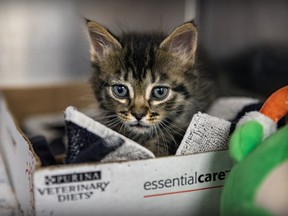There are telltale signs that a cat isn’t doing well and handy tools to find out whether the cat has a family.

Article content
Cats are no strangers to Montreal streets and in a bustling city, it’s fair to wonder if they’ve lost their way and need help.
Neighbourhood Facebook groups are often inundated with photos of cats with captions asking if they belong to anyone in the area, so much so that the posts occasionally prompt responses pointing out that not every cat is in need of help, some are simply allowed outdoors.
Advertisement 2
Story continues below
Article content
So, how can you tell? There are telltale signs that a cat isn’t doing well, according to those who run shelters and rescues, and some handy tools to find out whether the cat has a family.
“The first thing we try to tell people is if the cat is in good body condition, if he doesn’t look hurt or sick in the first place, you shouldn’t take a cat from the street,” said SPCA spokesperson Marilou David. “If he looks healthy … at this point it’s not necessary to intervene.”
How to tell if a cat needs help

Anjali Choksi, who runs Montreal cat rescue Pussy Patrol, which helps 60 to 70 cats per year, said there are a few questions she asks when contacted: “Is the cat just occasionally there? Does the cat look well fed? Does the cat look groomed?”
“My first step is always to ensure that the cat really doesn’t have a home,” she said. “Why they think the cat is homeless is what I need to find out.”
If a cat is injured or full of parasites, there’s a possibility that it needs help, David added.
If a cat’s condition deteriorates — especially in the months following July 1, Moving Day — it’s possible that it’s been abandoned, Choksi said. She added that a cat sleeping outside overnight in the summer might be all right, but is typically a warning sign in the winter.
Article content
Advertisement 3
Story continues below
Article content
A mother with newborn kittens outside could be a sign she’s a stray, Choksi said.
Be aware, however, that a cat looking for food doesn’t necessarily mean it doesn’t have a home, David said.
“Sometimes (cats are) really greedy and sociable and will go begging for food from anyone who seems willing to give it to them.”
She added that a neutered cat wearing a collar is likely fine.
What to do if a cat seems like it needs help

If you’ve determined a cat meets the above criteria, the first thing Choksi and David recommend is checking if it has a microchip. Local shelters and rescues often have microchip readers, so if you contact one, they may be able to come to you. Otherwise, all vet offices have readers and will check free of charge. Microchip readers can also be purchased online.
“A microchip is always our first response,” Choksi said.
The second tip is to put a snap-off collar with a note on the cat, asking if it has a home.
“That sometimes works, someone calls and says ‘Yeah, it’s my cat,’” Choksi said. “We ask for that to be two to three days a least, before coming to the conclusion if the cat has a home or not.
Advertisement 4
Story continues below
Article content
“Presumably, over three days, the cat is gonna go home, someone’s gonna notice, someone’s gonna read, someone’s going to call you.”
Choksi also suggests talking to neighbours to see if anyone recognizes the cat and knows to whom it belongs.
David added that posting in neighbourhood Facebook groups can also be helpful.
“Many times people will answer: ‘Yes, that’s my cat, and he’s fine,’” she said.
David warned against taking a seemingly healthy cat to a shelter straight away because if no one claims it within three days, the SPCA is legally allowed to put it up for adoption. Not everyone is familiar with the shelter system and some don’t think to look for their lost pet there, she said.
“If the cat is already adopted by a new family, it’s just too late,” David said. “And it’s sad because those families, their cat was healthy, he was just roaming outside, he’s just an outdoor cat … he doesn’t need help, and then you put him in a shelter — a stressful environment — and they take resources from the shelter. It’s just not good for the cat, not good for the shelter, not good for the family.”
Advertisement 5
Story continues below
Article content
Tips for those who let their cats outdoors

Some shelters and rescues, such as Pussy Patrol, require that adoptive families keep their cats indoors. The SPCA used to be more strict about this, David said, but has recently chosen to focus its efforts on education.
“When someone mentions they’ll be letting their cats go outside, first we’ll suggest an animal that might be suitable for this lifestyle, for example an adult cat that was already used to going outside in his former home,” David said. “Also, we will inform the person about the risks involved.”
Risks include injuries, infections and parasites, she explained.
“Of course, veterinary fees can go higher for cats who go outside,” David said.
What’s more is that cats kill an estimated 100 million to 350 million birds per year in Canada, she said. They’re the leading cause of bird mortality, and are responsible for the extinction of several small species.
“But if someone decides to let their cat go out, we give them recommendations,” David said. “For example: make sure a cat is spayed or neutered and has a tag, a microchip, a (quick-release) collar with current contact information.”
Advertisement 6
Story continues below
Article content
Those are also the best ways to ensure someone doesn’t mistake your cat for a stray and take it to a shelter or a rescue, Choksi added — especially the microchip.
“The most failsafe way someone with an outdoor roaming cat can ensure that they don’t get mistakenly taken out of somebody having good intentions — but badly executed — would be to microchip,” she said.
Choksi stressed ensuring the information on the microchip is up to date.
“We’ve also had cases where there’s a microchip, but the information leads us nowhere … so I can’t contact (them),” she said. “At that point, you wonder: ‘If somebody hasn’t updated their information, does it mean they abandoned their cat?’”
If your cat disappears, the best thing you can do in addition to posting on social media is poster the neighbourhood, Choksi said, since not everyone is online. Be sure to put the posters in every mailbox within a one-block radius.
Recommended from Editorial
Advertisement 7
Story continues below
Article content
Article content


Comments